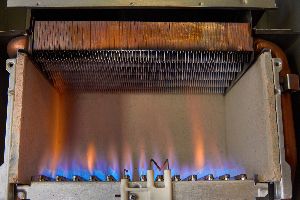What to Know About Your Furnace's Heat Exchanger

The heat exchanger is like the heart of your furnace. When it's not functioning properly, you might notice a change in your system's performance, but it's also essential to understand that it also represents a safety risk that needs to be addressed by a furnace repair technician. Here's a look at how this part works to help you identify a potential concern as soon as it arises.
How Does a Furnace Heat Exchanger Work?
Positioned between the combustion chamber and blower, this thin metal component is responsible for transferring heat that's generated in the combustion chamber to the outer portion of the unit. The heat then filters into air ducts and exits through vents in different parts of the home.
To accomplish this goal, combustion from natural gas or propane filters into the heat exchanger. This gas is hot, which causes the metal to become hot as well. The heat radiates from the metal, warming the surrounding air.

In addition to a primary heat exchanger that performs the aforementioned function, high-efficiency furnaces also feature a secondary stainless steel exchanger. When the hot flue gas exits the primary heat exchanger, it flows to the next, generating more warm air. The water vapor that forms as the metal gets hot also discharges underlying heat.
What Potential Problems Should You Be Aware Of?
Routine HVAC maintenance is essential to maintain proper heating system function. A furnace repair contractor will replace the air filter to maintain proper airflow and prevent the heat exchanger from overheating. Extreme temperatures could warp and crack the metal over time, allowing gases to escape instead of being channeled safely out of the home.
Harmful gases are natural byproducts of fuel combustion. Sulfur dioxide can irritate your lungs, nitrogen oxides can cause nausea, and carbon monoxide can lead to dizziness, weakness, shortness of breath, and other life-threatening health concerns.
In addition to changing the air filter, a furnace repair technician will perform a visual inspection of the heat exchanger to check for existing holes and cracks. They'll also identify weak spots that have formed due to the expansion of the metal when it heats up and contraction as it cools again. If problems are found, they may need to replace the heat exchanger to restore the airtight seal and keep the household safe.
To maintain heating efficiency and ensure your family's health during Midwest winters, reach out to the licensed and bonded HVAC contractors at Anderson Automatic Heating & Cooling in Cincinnati, OH. For more than 85 years, the knowledgeable professionals have been performing furnace repairs to extend the life of homeowners' heating systems in the Hamilton County area. Read feedback from satisfied customers online and call (513) 574-0005 for a service estimate.
About the Business
Have a question? Ask the experts!
Send your question

